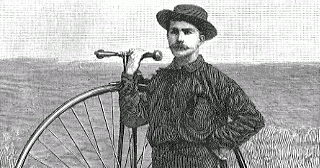From time to time even some of the greatest and most prolific heroes in all of sports fall through the cracks of obscurity and are lost to the world at large. “Legends of the periphery” celebrates the best of the best among the forgotten, the bizarre, the esoteric and the obscure.
What’s the longest distance you’ve ever traveled on a bike? Was it around the world? In 1884 Thomas Stevens embarked on a journey starting in San Francisco that saw him cross the continent to Boston, cycle his way through both Europe and Asia and accumulate approximately 13,500 riding miles, before wheeling his way home to the East Coast of the United States. Stevens was the first person to ever circle the globe using a bicycle as the primary means of transportation. This is an incredible record to be sure, but what makes Stevens’ feat even more Herculean is the fact that he spent the entire trip riding a penny-farthing.
What is a penny-farthing you ask? Imagine a bicycle in which the back tire is slightly larger than a Frisbee and the front tire is the size of a perfectly round dinner table. The cycle was named after the similar size discrepancy in British coins between the penny and the farthing (quarter penny). Although not as flashy a name as other turn of the century bicycles such as the dandy horse, the penny-farthing was the toast of the town, undoubtedly the most popular bicycle of the late 1800s. Whether in Los Angeles or London it was not uncommon to see the most dapper of gentlemen and the fairest of ladies cruising down the streets on their very own big-wheeled contraptions.
Born 1854, Stevens came from meager beginnings, immigrating to America in 1872 from England with no professional trade and no real job prospects. After several years drifting from one job to another, including his longest stint as a miner in Colorado, Stevens set his gaze toward the illustrious world of the long-distance-cycler. Perhaps it was fame the would-be high wheeler sought, or maybe the glory of owning such a lofty record was enough to draw Stevens into attempting such a feat. It certainly couldn’t have been a pure love for the activity itself as Stevens, by the time he had decided to ride around the world, had never actually rode a bicycle.
Determined to become one of the world’s most prolific cyclists, Stevens purchased a 50-inch standard model penny-farthing built by the Pope Manufacturing Company and spent weeks training in Golden Gate Park, teaching himself the art of the high wheel until he deemed himself proficient enough to brave any and all possible conditions. The provisions Stevens set off with included: socks, a spare shirt, a raincoat that doubled as a tent, and a 38 Smith and Wesson. Because there were so few automobiles when Stevens began his great quest he had to limit the majority of his cycling to wagon trails, towpaths, limited public roads, and, on several occasions, railroad tracks. Of course the penny-farthing was never built to conquer the same terrain as the steam powered train so most often Stevens would have to walk his mechanical companion, hopping the rails, hoping never to hear the distinct whistle of a locomotive bearing down from behind. Imagine the railway scene from Stand By Me, only this time Corey Feldman’s character has a 19th-century moustache and is carrying a ridiculously oversized means of conveyance. Yes, you get the picture.
Once passed the United States, Stevens’ journey took him through England, Germany, Hungary, Bulgaria and Turkey. Along the way the former miner became a working travel correspondent for several major publications, gained legendary notoriety among cycling circles, and was even joined by a temporary cycling partner with which he shared no common language. In Iran, Stevens waited out the winter months as a guest of the Shah before once again setting out only to be refused entry to Siberia and subsequently thrown out of Afghanistan. By the midway point of his travels, no matter where our hero went his presence was polarizing; people either loved him or hated him. After making his way through India, Stevens met one of his toughest challenges yet; exhibiting many traits characteristic of the Western world, Stevens had to navigate his way upward through China right in the midst of an ongoing war with the French. Although he had little to no association with the French, the Chinese characterized Stevens as diabolic and stoned him on numerous occasions. According to Thomas Pauly of the University of Delaware, the high-wheeler was lucky to get out of China and into Japan with his life.
By 1887, Stevens had finally returned home after two and a half years of cycling his penny-farthing across the United States, Europe and Asia, becoming the first person to cycle around the world. After his return, Stevens collected a large number of letters he had sent to Harper’s Magazine over his trip and compiled them into a two volume book, Around the World on a Bicycle, still available today for those book hunters savvy enough to seek it out. In later years Stevens continued to write travel literature of various kinds including a book of observations on Russian culture pieced together from an expedition across Russia made entirely on a mustang. Yet again Stevens found a home in riding something for an incredible stretch of time and then writing about it. Move over Lance Armstrong, Thomas Stevens is the only cyclist I care to discuss.

